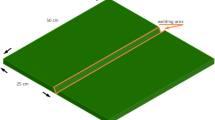Abstract
Prestressed concrete structures have been widely used all over the world, and there is a growing need to study the postfire repairability that is relevant whenever a fire occurs and no collapse happens after cooling. To evaluate the damage to the structure after fire exposure, the residual mechanical properties of structural materials need to be evaluated first. A literature review is conducted to analyse the major factors influencing the post-fire properties of prestressing steel. Existing test data are collected from an extensive survey of the available literature. Based on statistical analysis, the effects of heat exposure on the modulus of elasticity, yield strength and tensile strength, as well as ultimate strain, are analysed. A simplified stress–strain model is developed for prestressing steel in residual conditions (i.e. after heating and cooling to room temperature). Measured stress–strain curves are used to verify the accuracy of the proposed model.










Similar content being viewed by others
References
Lin TY, Burns NH (1981) Design of prestressed concrete structures. Wiley, New York
Gales J, Bisby LA, Gillie M (2011) Unbonded post tensioned concrete in fire: a review of data from furnace tests and real fires. Fire Saf J 46(4):151–163
Guyon Y (1953) Prestressed concrete. Wiley, New York
Standard Australia (2009) Concrete structures. Standards Australia, AS 3600-2009, Sydney
British Standards Institution (2004) Design of concrete structures—Part 1-1: general rules and rules for buildings. British Standards Institution, Eurocode 2, BS EN 1992-1-1:2004, London
Gilbert RI, Mickleborough NC (1990) Design of prestressed concrete. Unwin Hyman Ltd., London
Hurst MK (1998) Prestressed concrete design. E & FN SPON, London
Precast/Prestressed Concrete Institute (Precast/PCI) (2010) PCI design handbook, Precast and prestressed concrete, 7th edn. Precast/Prestressed Concrete Institute, Chicago
Toribio J (2004) Relationship between microstructure and strength in eutectoid steels. Mater Sci Eng, A 378–389:227–230
Tao Z, Wang XQ, Uy B (2013) Stress-strain curves of structural and reinforcing steels after exposure to elevated temperatures. J Mater Civ Eng 25(9):1306–1316
Felicetti R, Gambarova PG, Meda A (2009) Residual behavior of steel rebars and R/C sections after a Fire. Constr Build Mater 23(12):3546–3555
Day MF, Jenkinson EA, Smith AI (1960) Effect of elevated temperatures on high-tensile-steel wires for prestressed concrete. ICE Proc 16(1):55–70
Abrams MS, Cruz CR (1961) Behavior of high temperatures of steel strand for prestressed concrete. J PCA Res Dev Lab 3(3):8–19
Abrams MS, Erlin B (1967) Estimating post-fire strength and exposure temperature of prestressing steel by a metallographic method. J PCA Res Dev Lab 9(3):23–33
MacLean KJN (2007) Post-fire assessment of unbonded post-tensioned concrete slabs: strand deterioration and prestress loss. Master’s thesis, Department of Civil Engineering, Queen’s University, Ontario
Avner SH (1974) Introduction to physical metallurgy. McGraw-Hill, New York
Shen R, Rong K, Feng LY (1991) Mechanical properties of reinforcing bars after exposure to elevated temperatures or fire. Build Sci Res Sichuan 17(2):5–9 [in Chinese]
Neves IC, Rodrigues JPC, Loureiro AP (1996) Mechanical properties of reinforcing and prestressing steels after heating. J Mater Civ Eng 8(4):189–194
Fan J (2001) Fire resistance of unbonded prestressed concrete structures. PhD thesis, School of Civil Engineering, Southeast University, Nan**g [in Chinese]
Crook RN (1980) The Elevated Temperature properties of reinforced concrete. PhD thesis, University of Aston, Birmingham
Moore WL (2008) Performance of fire-damaged prestressed concrete bridges. Master’s thesis, Faculty of the Graduate School, Missouri University of Science and Technology, Rolla, Missouri
Atienza JM, Elices M (2009) Behavior of prestressing steels after a simulated fire: fire-induced damages. Constr Build Mater 23(8):2932–2940
Falkner H, Gerritzen D (2004) Prestressed slabs without bond. Structural and serviceability behaviour after fire exposure. Beton- und Stahlbetonbau 99(8):652–656 [in German]
Deng CN (2005) Studies of mechanics characters on main beam of prestressed concrete undergone high temperature. Master’s thesis, College of Resources and Civil Engineering, Northeastern University, Shenyang [in Chinese]
Zheng WZ, Hu Q, Zhang HY (2007) Experimental research on the mechanical property of prestressing steel wire during and after heating. Front Archit Civ Eng China 1(2):247–254
Gálvez F, Atienza JM, Elices M (2011) Behaviour of steel prestressing wires under extreme conditions of strain rate and temperature. Struct Concr 12(4):255–261
Skogman BC, Tadros MK, Grasmick R (1988) Flexural strength of prestressed concrete members. PCI J 33(5):96–123
Fédération internationale du béton (fib) (2012) Model code 2010-final draft, vol 1. FIB Bulletin No 65, Lausanne
Ministry of Housing and Urban-Rural Development of the People’s Republic of China (2011) Code for design of concrete structures. GB50010-2010, China Architecture & Building Press, Bei**g [in Chinese]
Standard Australia/Standards New Zealand (2009) Steel prestressing materials, part 1: general requirements. Standard Australia, AS/NZS 4672.1:2007, Sydney
Acknowledgments
The author would like to thank Mr Henry Huynh for his assistance in collecting the test data.
Author information
Authors and Affiliations
Corresponding author
Rights and permissions
About this article
Cite this article
Tao, Z. Mechanical properties of prestressing steel after fire exposure. Mater Struct 48, 3037–3047 (2015). https://doi.org/10.1617/s11527-014-0377-5
Received:
Accepted:
Published:
Issue Date:
DOI: https://doi.org/10.1617/s11527-014-0377-5




